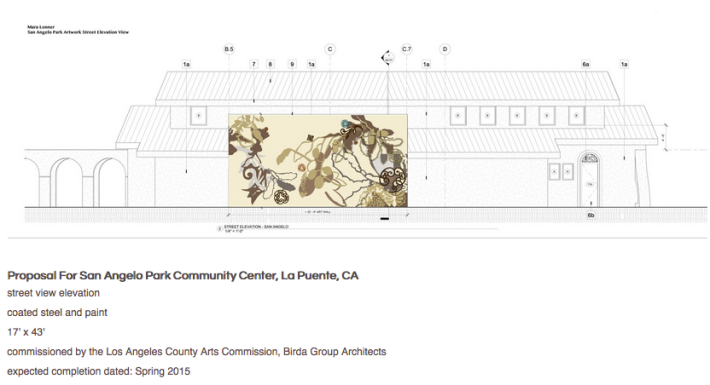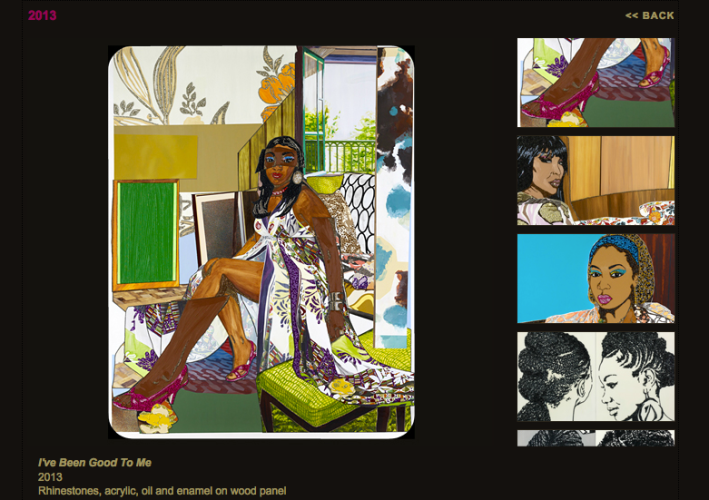
Crenshaw Boulevard may be chaotic to navigate due to the construction of the Crenshaw/LAX Line at the moment, but good things appear to be in the works. The Source reported Wednesday that the new stations will be graced with works from a diverse mix of 14 artists.
If you've ridden any of the rail lines, you've probably noticed that the stations are unique and play host to artwork that is intended to ground the stations in or make some connection with the surrounding community. This is because 0.5 percent of rail construction project costs are put towards the creation and installation of original artwork at each station.
The formal linking of art with transit began in the 1970s, according to a best practices report by the American Public Transportation Association (APTA). After the U.S. Department of Transportation (DOT) offered its support for high quality art and design in federally-funded transit projects and the National Endowment for the Arts published a case study of federal design projects, then-President Jimmy Carter asked the DOT to take a step further and support projects that contributed to the architectural and cultural heritage of local communities. As a result, in 1978, Boston, Atlanta, and Baltimore received official support from the Design, Art and Architecture program for permanent public art projects. Boston's Art on the Line program, which grew out of that initiative, helped set the standard for the integration of public art in transit systems around the country.

The 0.5% of construction costs that Metro allocates for art projects is the minimum required by the Federal Transit Authority (the maximum is 5%), and smaller than the national average APTA cites as being between 1% and 2%. But, since 1989, that 0.5% has allowed the Metro Art program to commission over 250 artists for temporary or permanent projects at transit stations.
The projects range from the beautiful Festival of Masks Parade mural by Frank Romero at Wilshire/Normandie, to the intriguing About Place, About Face installation of 27 larger-than-life faces of area residents by Rob Nielson at the Pico-Aliso station, to the downright puzzling and possibly disturbing I Dreamed I Could Fly installation of what appears to be people falling from the sky by Jonathan Borofsky at Wilshire/Vermont (at right). See the full art guide, here.
Putting art in transit stations, says APTA, encourages ridership, improves perceptions of transit, conveys a sense of customer care, enhances community livability, improves customer experiences, improves organizational identity for transit agencies, deters vandalism, and increases safety and security. Which are all fantastic arguments for integrating art at key (and, generally, heavily neglected) bus stops, I might add, but I digress.
In selecting the finalists for the Crenshaw Line, The Source reports that the selection panel assessed how the proposed works would relate to the sites and surrounding communities, while also engaging and enhancing the transit rider's experience along the line. The final works will take a variety of forms -- the artists all work in a variety of media -- and be fortified by glass, tile, stainless steel, mosaics, or porcelain enamel.
So, whose work can you look forward to seeing and what kind of work have they done in the past?
The above-ground station at Crenshaw/Expo is already graced with the work of the late Willie Middlebrook, Jr. (photo at top). The underground station (currently under construction) will host the work of three artists: Rebeca Méndez, Jaime Scholnick, and Erwin Redl.
Méndez, born in Mexico City and a long-time L.A. resident and professor in the department of Design Media Arts at UCLA, works in a variety of media. She is interested in the nature of matter—in cycles and systems, specifically the forces and cross-rhythmic tensions that make natural phenomena emerge. Having grown up in both Mexico City and the Mexican jungle, where she would follow her father in pursuit of Mayan archaeology, she explores how cultures express themselves through the style of nature that they produce at a given time and the medium through which they construct this nature.


Erwin Redl is an Austrian-born Ohio resident whose work "reflects upon the condition of art making after the 'digital experience.'" Using installations, drawings, CD-ROM, Internet, and sound, he assembles materials according to a narrow set of self-imposed rules, algorithms, controlled randomness, and other methods inspired by computer code. That may sound like an odd fit for a Metro station, but he's done some large public projects involving LED programming, like the North Carolina underpass, below.

Light Installation with Animated RGB LED Fixtures. (screen shot from his web page)
The Crenshaw/MLK station will also host the work of three distinct artists.
Mara Lonner is an L.A.-based artist who works with a variety of mediums and genres in order to blur the distinction between the organic and the geometric. Her more recent work has focused on the "beautiful tenacity of nature." Her most recent projects were public commissions -- an installation for the San Angelo Park community center in La Puente (an L.A. County Arts commissioned work) and in collaboration with another Kim Schoenstadt (also a featured artist on the Crenshaw Line, below) on an installation for the Intergenerational Center in the Valley.

Photographer and video artist Eileen Cowin has already done work for Metro. Her installation, "I See What You’re Saying (train of thought)," was featured on Metro light boxes at the Wilshire/Normandie station in 2001 (below). In a conversation with the Getty, she described the series as being inspired by lying and the ways in which words and communication can be deceitful. Her work often takes the form of elaborate staged scenes meant to convey ideas and inspire reflection.

Shinique Smith's vibrant and colorful work mixing paints, fabric, and other cast-off items, according to the New York Times, draws
bountifully on her formative experiences with dance, graffiti, Tibetan culture and fashion, synthesized with influences that range from Jean-Michel Basquiat to Japanese calligraphy. While her work shares certain attributes with Abstract Expressionism, she says she’s coming from a very different place. “I’m not a white man with an eye on redefining painting itself."[...]“I think the consumerism, the clothing, the trappings, the shedding skins, the little bits make us who we are,” she added. “I try to string it all together.”
At the Crenshaw/Vernon Leimert Park station, three artists' work will be showcased.
NY-based painter Ingrid Calame focuses her gaze on the left-over and often overlooked remnants of human interaction with the public space. She will often trace the shapes of stains on a sidewalk, graffiti on a river bank, tire skid marks on a roadway and use the tracings to generate abstractions, a process she refers to as "representation of loss." And while that might sound depressing, the resulting works are often incredibly colorful, if a little bit ghostly.

According to her artist statement, using still images and video, Deanna Erdmann engages
perception and transformation, addressing the politics of place, class, and the body. Through the reconfiguration and denaturalization of image, time, and sound, my work seeks out the invisible within the visible. I start with the still image as a foundation for contemplation. Using transitory, repeated, and improvised gestures I propose new strategies for viewing that challenge habitual engagement and perception. The resulting combinations of images, movement and sound coalesce, creating visceral and meditative experiences.

Finally, NY-based Mickalene Thomas introduces a complex vision of what it means to be a woman and expands common definitions of beauty via elaborate paintings composed of rhinestones, acrylic, and enamel. Her influences run from Manet and Matisse to popular culture and Pop Art.

The remaining five stations will each host work from a single artist.
The Crenshaw/Slauson will feature work by painter Carlson Hatton. Hatton uses watercolor washes, acrylic, graphite, and oil to create layers that generate a sense of "architectural impossibility." Exploring the relationships between the fusion of environment and figure, the passage of time, and the glow of light signifying celestial intervention by creating alternate environments with re-contextualized echoes of the vaguely familiar, his work searches for "meaning, unity, or at least overlap."

At Florence/La Brea, you will find the work of Kenturah Davis. A local artist, Davis explores themes related to the body, language, the formation of identities, and the way we perceive each other using portraiture and design. For her first public commission, Four Women, at Alliance Français d’Accra, Ghana, she identified four local women who were making interesting contributions to their communities and used them as inspiration. Repeating the hand-written text, "I am deliberate and afraid of nothing," (Audre Lorde) throughout the piece served as a metaphor for the way that we acquire and inhabit language, according to Davis, and made the work itself a performative act, rendering the process of making it is as important as the finished piece.

The Florence/Hindry stop will feature the work of L.A.-based Geoff McFetridge, who made a faux map of L.A.'s Metro system for the film, Her. His drawings tend toward the simple or abstract in construction; he also does animation and graphic design. Although it does appear that, in the future, South L.A. may have been swallowed up in an earthquake (save Compton, which apparently migrated toward LAX and Santa Monica), it would be nice if our Metro system was this built-out sooner rather than later.

Artist Kim Schoenstadt's work will be featured at the Florence/West Station. The Venice-based artist "explores the junctures of architecture, sculpture, color, line, history, culture and concepts, creating 'mash-up drawings' that allow her to defy the laws of gravity while incorporating architecture into site-specific installations that engage audiences throughout the construction process." Los Angeles Times art critic Christopher Knight described her painting as "charting the intersection between the bricks and mortar of actual city streets and the effervescent elements of virtual reality" and likened that to the world we live in now.

Last but not least, Egyptian-born, L.A.-based Sherin Guirguis' work will grace the Aviation/Century stop. Her gorgeous and intricate work juxtaposes the "reductive Western language of minimalist aesthetics with that of Eastern Arabic ornamentation." Sometimes that manifests in sculpture, and sometimes it manifests in ornate hand-cut paper and mixed-media pieces that incorporate both the traditional and the modern while investigating the frictions between them.

The projects the artists will produce for the stations have not yet been released, but Metro does promise it will be hosting meet-the-artists events and stories related to upcoming artworks in the not-so-distant future. For more on Metro's art program, please visit their page, here.







